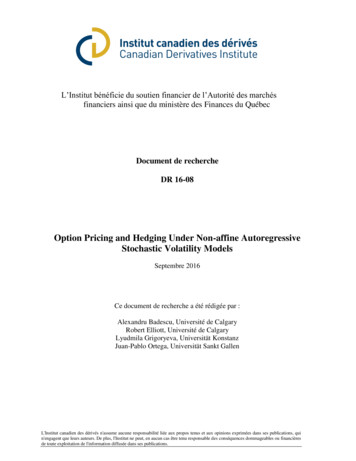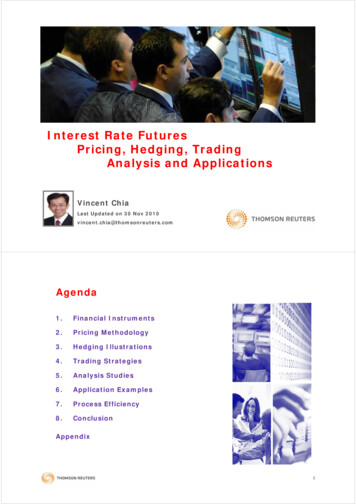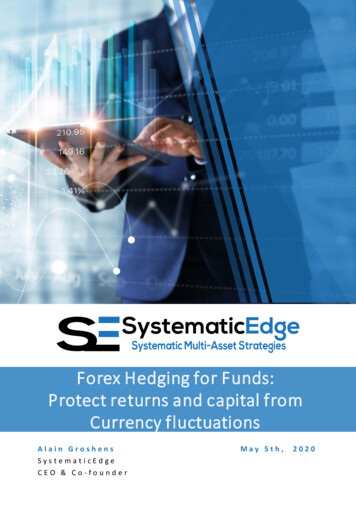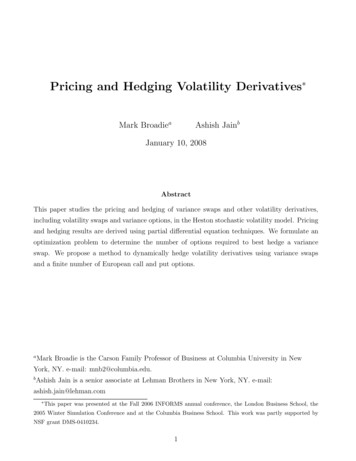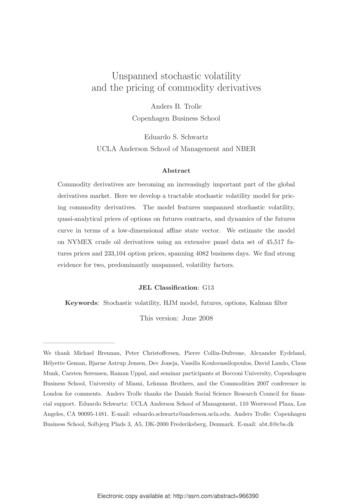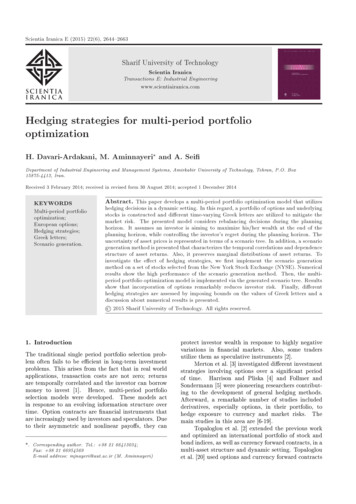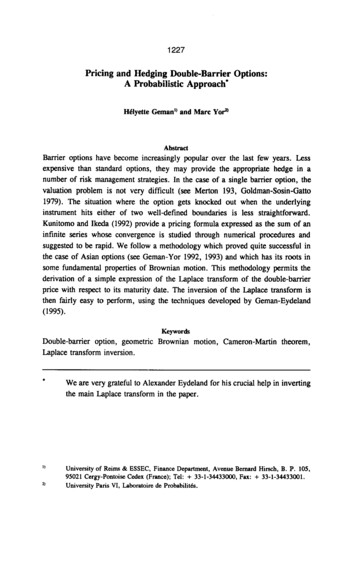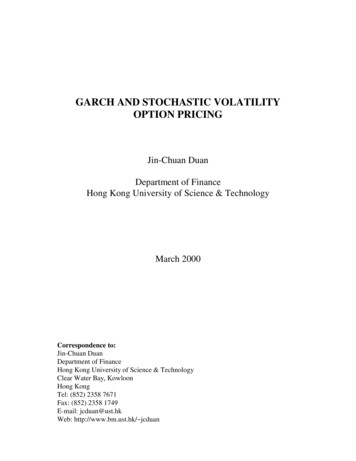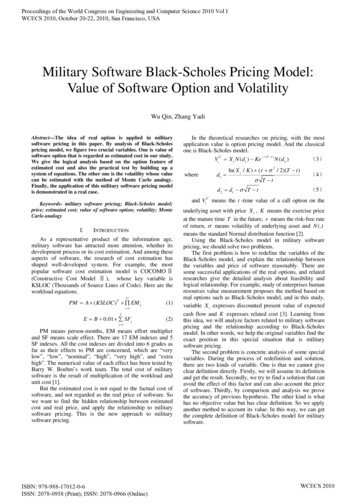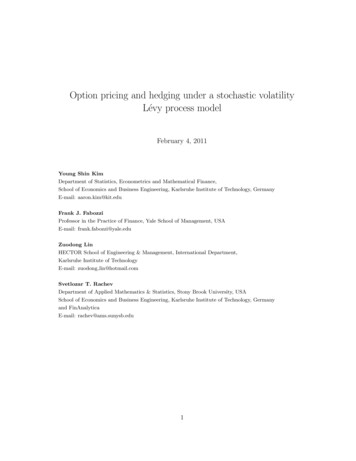
Transcription
Option pricing and hedging under a stochastic volatilityLévy process modelFebruary 4, 2011Young Shin KimDepartment of Statistics, Econometrics and Mathematical Finance,School of Economics and Business Engineering, Karlsruhe Institute of Technology, GermanyE-mail: aaron.kim@kit.eduFrank J. FabozziProfessor in the Practice of Finance, Yale School of Management, USAE-mail: frank.fabozzi@yale.eduZuodong LinHECTOR School of Engineering & Management, International Department,Karlsruhe Institute of TechnologyE-mail: zuodong lin@hotmail.comSvetlozar T. RachevDepartment of Applied Mathematics & Statistics, Stony Brook University, USASchool of Economics and Business Engineering, Karlsruhe Institute of Technology, Germanyand FinAnalyticaE-mail: rachev@ams.sunysb.edu1
AbstractIn this paper, we construct a new stochastic volatility model with a Lévy driving process and then apply the model to option pricing and hedging. The stochasticvolatility in our model is defined by the continuous Markov chain. We use the Esscher transform to find the equivalent martingale measure. The option price usingthis model is obtained by the Fourier transform method. We obtain the closed-formsolution for the hedge ratio by applying the local risk minimizing hedging.Keywords: Option pricing; Hedging; Stochastic volatility; Continuous Markov chain;Regime-switching; Lévy process, Esscher transformJEL Classifications: C6, G11, G12, G131IntroductionThe skewness and heavy-tail property observed for return distributions and the timevarying volatility of the return process are two major issues for modeling underlying returnprocesses and option pricing. The skewness and heavy-tail property can be described bythe non-Gaussian infinitely divisible distributions (see Rachev et al., 2011). The timevarying volatility models for option pricing has been studied for the following three majorclasses of models: (1) continuous time and continuous market volatility, (2) discrete timeand continuous market volatility, and (3) continuous time and finite market volatility.The stochastic volatility model by Heston (1993) belongs to the first class since themodel is a continuous-time model and the volatility in this model is defined on all positivereal numbers. The stochastic volatility Lévy process model by Carr et al. (2003) is alsoincluded in the first class. Option pricing with the GARCH model as proposed by Duan(1995) is a discrete-time model, but volatility is defined on the all positive real numbers.Hence, the model is included in the second class. The model was subsequently enhancedby several researchers. For example, Menn and Rachev (2009), Kim et al. (2009), andKim et al. (2010) replace the Gaussian innovation in Duan’s model with the α-stable and2
the tempered stable innovation process. If market volatility is modeled by the finite statescontinuous Markov chain, then this model is referred to as a regime-switching model (seeBuffington and Elliott (2002) and Elliott and Kopp (2010)) and belongs to the third class.The main issue associated with option pricing is finding a risk-neutral measure; thatis, finding an equivalent martingale measure (EMM) corresponding to the market probability measure1 of the underlying stock return process. The Girsanov theorem has beensuccessfully applied to find the EMM in time-varying volatility models having Brownianmotion as a driving process such as the stochastic volatility model by Heston (1993) andthe GARCH option pricing model by Duan (1995). However, the Girsanov theorem cannot be applied to general time-varying volatility models with Lévy driving processes. Oneclassical method to find an EMM for non-Gaussian Lévy process models is the Esschertransform presented by Gerber and Shiu (1994); another reasonable method is finding the“minimal entropy martingale measure” presented by Fujiwara and Miyahara (2003). Kimand Lee (2007) discuss the EMM on a tempered stable process model with the generalizedGirsanov theorem by Sato (1999). Finding an EMM with the Esscher transform for aregime-switching model with Brownian motion is addressed in Elliott et al. (2005).In the Black-Scholes model (Black and Scholes, 1973), the market is assumed to becomplete so that a perfect hedge can be attained by delta hedging. However, generallyin an incomplete market, a perfect hedge is not attainable. Föllmer and Schweizer (1990)propose what they refer to as a local risk-minimizing method for constructing a portfoliocontaining options and underlying stocks that minimizes the variance based on the physicalmarket measure. Boyarchenko and Levendorskiĭ (2002) discuss the local risk-minimizinghedging under the exponential Lévy stock price model and find an explicit form for thehedge ratio.1The market probability measure is the probability measure for the physical price process of the underlying stock. Another name for the market probability measure is the physical measure. Typically themeasure is estimated using the underlying stock’s historical returns.3
The purpose of this paper is threefold. First, we construct a stochastic volatility modelwith a Lévy driving process and then discuss the option pricing and hedging problems usingthis model. The stochastic volatility in our model is defined by the continuous Markovchain, the same approach as the regime-switching model. Although Jackson et al. (2007)also discuss regime-switching with Lévy driving process, their approach does not focuson stochastic volatility and therefore differs from our model. Second, we explain how tofind the equivalent martingale measure (EMM) using the Esscher transform under thenew stochastic volatility model and provide the European option pricing formula underthis measure. Finally, we apply local risk-minimizing hedging for the stochastic volatilitymodel with a Lévy driving process and present an explicit form for the hedge ratio.The remainder of this paper is organized as follows. In Section 2, The Markov chainstochastic volatility Lévy process model is constructed and then Esscher transform arediscussed. we provide the option pricing formula for the model in Section 3. Local riskminimizing hedging under the model is presented in Section 4. In Section 5, we summarizeour principal findings.2Markov chain stochastic volatility Lévy process modeland Esscher transformSuppose (L(t))t 0 is a Lévy process on a complete probability space (Ω, P, F). We assumethat the states of the economy are modeled by a continuous-time hidden Markov chainprocess (X(t))t 0 generated by a generater matrix A on (Ω, P, F) with a finite state spacewhich is a finite set of unit vectors {e1 , e2 , · · · , eN }, where en (0, · · · , 1, · · · 0)0 RN .Then, we have the following semi-martingale representation theorem for {X(t)}t 0 :tZX(t) X(0) AX(s)ds M (t),04(1)
where (M (t))t 0 is an RN -valued martingale increment process with respect to the filtration generated by {X(t)}t 0 . We assume that {X(t)}t 0 and {L(t)}t 0 are independent and EP [exp(uL(t))] if u I for some real interval I. We denote Φ(z) log E[exp(zL(1))]. The domain of Φ(z) is extended to a complex subset {z C : (z) I}by the analytic continuation in complex analysis (see Chruchill and Brown, 1990). Let(FtX )t 0 and (FtL )t 0 be the natural filtrations generated by (X(t))t 0 and (L(t))t 0 , respectively. We define a filtration (Gt )t 0 such that Gt is the σ-algebra generated by FtXand FtL for all t 0.The stock price process (S(t))t 0 is referred to as the Markov chain stochastic volatilityLévy process model if S(t) is given by ZtZhµ, X(s)ids S(t) S(0) exp0tZ hσ, X(s)idL(s) ,Φ(hσ, X(s)i)ds 0t(2)0where µ (µ1 , µ2 , · · · , µN )0 RN and σ (σ1 , σ2 , · · · , σN )0 RN with σn 0 and σn Ifor each n 1, 2, · · · , N . The value µ(t) hµ, X(t)i and σ(t) hσ, X(t)i are referredto as the expected return and the market volatility at time t, respectively. The process(S(t))t 0 is (Gt )t 0 -adapted.Lemma 1. Let 0 s t and y (y1 , y2 , · · · , yN )0 RN . The conditional characteristicRtfunction of s hy, X(u)idu under the σ-field FsX is equal to Z t XE exp i hy, X(u)idu Fs hexp[(t s)(A diag(iy))]X(s), 1i(3)swhere (FtX )t 0 is the natural filtrations generated by (X(t))t 0 and 1 (1, 1, · · · , 1)0 RN .Proof. Consider a process Z t Z(t) exp i hy, X(u)idu X(t).s5
Then Z t Z tdZ(t) exp i hy, X(u)idu dX(t) ihy, X(t)i exp i hy, X(u)idu X(t)dtssBy (1), we obtainZZ(t) Z(s) tZ(A idiag(y))Z(u)du t Z uhy, X(v)idv dMu .exp isssSince (M (t))t 0 is martingale, idiag(y) diag(iy), and Z(s) X(s), we obtain thefollowing equation by taking the conditional expectationE[Z(t) FsX ]tZ(A diag(iy))E[Z(u) FsX ]du, X(s) sand henceE[Z(t) FsX ] exp ((t s)(A diag(iy))) X(s).Therefore we obtain (3) as follows Z t Z tXXexp i hy, X(u)idu X(t), 1 FsE exp i hy, X(u)idu Fs E ss hexp[(t s)(A diag(iy))]X(s), 1i.Because the Markov process has a countable state space, the amount of time that thevolatility state stays on each state en for n 1, 2, · · · , N from 0 to time t is given as:τntZthen , Xu idu, (4)0wherePNtn 1 τn t. By substituting s 0 in equation (3) of Lemma 1, the characteristic6
t ) is obtained byfunction of the joint distribution of the random vector (τ1t , τ2t , · · · , τN"E exp iNX!#yk τnt hexp[t(A diag(iy))]X(0), 1i,(5)k 1where y (y1 , y2 , · · · , yN )0 , 1 (1, 1, · · · , 1)0 RN , and X(0) is the initial state. For0 s t, we have"E exp iNX!yk (τnt τns )#FsX hexp[(t s)(A diag(iy))]X(s), 1i.k 1Lemma 2. Let 0 s t, v (v1 , v2 , · · · , vN )0 RN , and w (w1 , w2 , · · · , wN )0 RNsuch that Φ(wn ) for all n 1, 2, · · · , N . ThenZthv, X(u)idu sZNXvn (τnt τns ),0 s t(6)n 1thw, X(u)idL(u) sNXwn L(τnt τns ),0 s t.(7)n 1and"EP expNXvn (τnt τns ) n 1NX!wn L(τnt τns )#Gsn 1 hexp[(t s)(A diagγ(x))]X(s), 1i,(8)where γ(x) (v1 Φ(w1 ), v2 Φ(w2 ), · · · , vN Φ(wN ))0 .Proof. Equations (6) and (7) are easy to prove. Equation (8) is proved using properties7
of the conditional expectation and independence between L(t) and τnt τns as follows:"EP expNXvn (τnt τns ) n 1"NX!wn L(τntNX EP EP expvn (τnt τns ) n 1 EP exp#Gsn 1"" τns )NXNX!wn L(τnt τns )#τnt τnsGsn 1!(vn #Φ(wn ))(τnt τns )#Gsn 1 hexp[(t s)(A diagγ(x))]X(s), 1i,where γ(x) (v1 Φ(w1 ), v2 Φ(w2 ), · · · , vN Φ(wN ))0 .By (6) and (7), we haveS(t) S(0) expNXµn τnt n 1NXΦ(σn )τnt n 1NX!σn L(τnt ) .(9)n 1We consider a financial model consisting of two risky underlying assets, namely a bankaccount and a stock, which are tradable continuously. The risk-free rate of return, denotedby r(t), at time t 0 is given by r(t) hr, X(t)i, where r (r1 , r2 , · · · , rN )0 RN withrn 0 for each n 1, 2, · · · , N and h·, ·i denotes the inner product in RN . The discountedstock price process (S̃(t))t 0 is defined by Z t S̃(t) exp hr, X(s)ids S(t).0By (6) and (7), we haveS̃(t) S(0) expNX(µn rn )τnt n 1Proposition 1. Let Z(t) Rt0 hσ, Xs idLs ,NXn 1Φ(σn )τnt NX!σn L(τnt )(10)n 1t 0. If there exist θ (θ1 , θ2 , · · · , θN ) RN8
which satisfies the condition Φ(θn σn ) Φ((1 θ )σ ) n n µn rn Φ(σn ) Φ(θn σn ) Φ((1 θn )σn )for all n 1, 2, · · · , N,(11)then the measure Qθ equivalent to the measure P with a Radon-Nikodym derivativedQθdPGt R texp 0 hθ, X(s)idZ(s)h R i , for t 0, tEP exp 0 hθ, X(s)idZ(s) FtXis an equivalent martingale measure (EMM).Proof. Let ξt dQθdP Gt .Then we have P R TNT τt)expθσL(τexphθ,X(s)idZ(s)nnn 1 n ntξT P P NNξtT τt)T τt)expΦ(θσ)(τexpΦ(θσ)(τn nn nnnnnn 1n 1andξTξtis independent to Gt . By (10), we haveNNXXS̃(T )(µn rn Φ(σn ))(τnT τnt ) σn L(τnT τnt ) expS̃(t)n 1n 1andS̃(T )S̃(t)!is independent to Gt . Hence we have"# ξTS̃(T ) ξTEP S̃(T ) Gt S̃(t)EP· GtξtS̃(t) ξt"! #NNXXTtTt S̃(t)EP exp(µn rn Φ(σn ) Φ(θn σn ))(τn τn ) (1 θn )σn L(τn τn ) Gt " S̃(t)EP expn 1NXn 1!#(µn rn Φ(σn ) Φ(θn σn ) Φ((1 θn )σn ))(τnT τnt ) Gt ,n 19by (8).
Therefore, ifµn rn Φ(σn ) Φ(θn σn ) Φ((1 θn )σn ),for n 1, 2, · · · , N,then S̃(t) EP ξTS̃(T ) Gt ,ξt0 t T,(12)and hence Qθ is an EMM corresponding to P.The method to find an EMM using Proposition 1 is referred to as the Esscher transformunder the Markov chain stochastic volatility Lévy process model. In the remainder of thispaper, we denote ξt dQθdP Gt .By the definition ofξt expNXdQθdP Gtin Proposition 1, we obtain that!(θn σn L(τnt ) Φ(θn σn )τnt ) .(13)n 13Option pricing under the Markov chain stochastic volatility Lévy process modelIn this section, we assume that (S(t))t 0 is given by the Markov chain stochastic volatilityLévy process model and Qθ is the EMM obtained by the Esscher transform. The expectedreturn and and the market volatility for (S(t))t 0 is supposed to be µ (µ1 , µ2 , · · · , µN )0and σ (σ1 , σ2 , · · · , σN )0 , respectively, the risk-free rate of return is supposed to ber (r1 , r2 , · · · , rN )0 , and we denote Y (t) log(S(t)/S(0)) in this section.The conditional characteristic function of Y (T ) Y (t) under measure P and the condition Gt is given byφPY (T ) Y (t) (u Gt ) EP [exp(iu(Y (T ) Y (t))) Gt ] hexp[(T t)(A diag(yP (u)))]X(t), 1i10
where iu(µ1 Φ(σ1 )) Φ(iuσ1 ) iu(µ2 Φ(σ2 )) Φ(iuσ2 ) yP (z) . . iu(µN Φ(σN )) Φ(iuσN ) . (14)Lemma 3. Let 0 t T . The conditional characteristic function of Y (T ) Y (t) undermeasure Qθ and the condition Gt is given byθφQY (T ) Y (t) (u Gt ) EQθ [exp(iu(Y (T ) Y (t))) Gt ] ξt hexp[(T t)(A diag(yQθ (u)))]X(t), 1iwhere ξt is given by (13) and yQθ (u) iu(r1 Φ((1 θ1 )σ1 )) Φ((iu θ1 )σ1 )iu(r2 Φ((1 θ2 )σ2 )) Φ((iu θ2 )σ2 ).iu(rN Φ((1 θN )σN )) Φ((iu θN )σN ) . (15)Proof. We haveEQθ [exp(iu(Y (T ) Y (t))) Gt ] ξt EP [exp(iu(Y (T ) Y (t)))ξT /ξt Gt ]"!NX ξt EP exp iu(µn Φ(σn ))(τnT τnt ) σn L(τnT τnt )n 1NX exp!θn σn L(τnT τnt ) Φ(θn σn )(τnT τnt )n 111 #Gt .
By the condition (11), we obtainEQθ [exp(iu(Y (T ) Y (t))) Gt ]"! #NNXXTtTtiu(rn Φ((1 θn )σn ))(τn τn ) (iu θn )σn L(τn τn ) Gt . ξt EP expn 1n 1By (8), we complete the proof.For convenience, we define a function on C [0, ) where C is the complex field thatMr,σ,θ (z, t, T ) hexp[(T t)(A diag(yQθ (z)))]X(t), 1i,z C, 0 t T,where yQθ (z) is given by (15).We obtain the option pricing formula under the Markov chain stochastic volatilityLévy process model by the Fourier transform method discussed in Carr and Madan (1999)and Lewis (2001) as follows.2 Let Π(ST ) be a payoff function of one European optionR with time to maturity T , h(x) Π(ex ) with x log S(T ), and ĥ(η)) e iηx h(x))dx.Suppose r r1 · · · rN and ĥ(η) is defined for all η Rh where Rh {z C :θIm(z) Ih } for some real interval Ih . The characteristic function φQY (T ) Y (t) (η) is definedfor all η Rφ where Rφ {z C : Im(z) Iφ } for some real interval Iφ . Based on theno-arbitrage pricing framework, the European option price V with time to maturity T isgiven by ξTV (t) EP exp( r(T t))Π(S(T )) Gtξthi1 EQθ e r(T t) Π(elog S(t) Y (T ) Y (t) ) Gtξte r(T t)EQθ [h(log S(t) Y (T ) Y (t)) Gt ] . ξt2This method is discussed in Liu et al. (2006) under the regime-switching model with Brownian motion.12
θSince the probability density function fYQ(T) Y (t) (x Gt ) of Y (T ) Y (t) under measure Qθand the condition Gt can be obtained byθfYQ(T) Y (t) (x Gt )1 2πZ θexp( i(u iρ)x)φQY (T ) Y (t) (u iρ Gt )duusing the complex inversion formula, we computeEQθ [h(Y (T ) Y (t)) Gt ]Z Z 1θ h(log S(t) x)e i(u iρ)x φQY (T ) Y (t) (u iρ Gt )du dx2π Z Z 1θ e i(u iρ)(x log S(t)) h(x)dx φQY (T ) Y (t) (u iρ Gt )du,2π and hencee r(T t)V (t) 2πξtZ θei(u iρ) log S(t) ĥ(u iρ)φQY (T ) Y (t) (u iρ Gt )du,(16)where ρ Ih Iφ . By the Lemma 3, we obtain the European option pricing formula underthe Markov chain stochastic volatility Lévy process model:e r(T t)V (t) 2πZ ei(u iρ) log S(t) ĥ(u iρ)Mr,σ,θ (u iρ, t, T )du.(17) In particular, the payoff function of a European call option with time to maturity Tand strike price K is given by Π(S(T )) (S(T ) K) and hence h(x) (ex K) ,where (·) max(·, 0). Therefore, we haveĥ(η) Ke iη log K,η(i η)(18)where η {u iρ ρ 1, u R}. By substituting (18) into (17), a European call option13
pricing formula at time t is equal toe r(T t) K 1 ρV (t) 2πS(t)ρZ eiu log(S(t)/K)Mr,σ,θ (u iρ, t, T )du,(ρ iu)(1 ρ iu)(19)where ρ is real number such that ρ 1 and yn (u iρ) for all n {1, 2, · · · , N } andu R. Moreover, by the property that ĥ( η; S(t)) ĥ(η; S(t)) for the payoff function ofa European call option, (19) becomese r(T t) K 1 ρReV (t) πS(t)ρZ0 eiu log(S(t)/K)Mr,σ,θ (u iρ, t, T )du.(ρ iu)(1 ρ iu)(20)We can compute a European put option’s price in the same way as for a European calloption. A European put option’s price can be obtained by the same formula as (20),but the condition of ρ is different; that is, ρ is a strictly positive real number such thatyn (u iρ) for all n {1, 2, · · · , N } and u R.4Local risk-minimizing hedge ratio under the Markov chainstochastic volatility Lévy process modelThe Markov chain stochastic volatility Lévy process model implies incomplete market.In an incomplete market, the perfect hedge for a general claim is no longer possible.In this section, we present the locally risk-minimizing hedge ratio which is discussed inBoyarchenko and Levendorskiĭ (2002) and deduce the explicit form of the hedge ratio inthe Markov chain stochastic volatility Lévy process model.Consider a European option with maturity T 0 and let V (t) be the European option’sprice at t. Let Wt t (ϕ) V (t t) ϕSt t at time t T . Let ϕ t (t) be the share of14
the underlying stock which minimizes variance of Wt t (ϕ). That isϕ t (t) arg min EP [(Wt t (ϕ) EP [Wt t (ϕ) Gt ])2 Gt ].(21)ϕThe locally risk-minimizing hedge ratio ϕt at time t is defined asϕ(t) lim ϕ t (t). t 0In this section, we assume that X(t t) X(t) for small t.Proposition 2. Let θ (θ1 , θ2 , · · · , θN )0 RN which satisfies the condition (11) andΦ(2σn ) for all n {1, 2, · · · , N } and let ρ R satisfy Φ((1 ρ)σn ) and Φ( ρσn ) for all n {1, 2, · · · , N }. The locally risk-minimizing hedging ratio is equal toe r(T t)2πS(t)h(diag(d(σ)) A)X(t), 1iZ ei(u iρ)Y (t) ĥ(u iρ)Mr,σ,θ (u iρ, t, T )h(diag(yH (u iρ)) A)X(t), 1idu,ϕ(t) (22)where Φ(2σ1 ) 2Φ(σ1 ) Φ(2σ2 ) 2Φ(σ2 ) d(σ) . . Φ(2σN ) 2Φ(σN ) Φ((iz 1)σ1 ) Φ(izσ1 ) Φ((iz 1)σ2 ) Φ(izσ2 ) and yH (z) . . Φ((iz 1)σN ) Φ(izσN )for z C.15
Proof. Since we haveEP [(Wt t (ϕ) EP [Wt t (ϕ) Gt ])2 Gt ] ϕ t (t)2 EP [S(t t)2 Gt ] (EP [S(t t) Gt ])2 2ϕ t (t)(EP [S(t t)V (t t) Gt ] EP [S(t t) Gt ]EP [V (t t) Gt ]) EP [(V (t t)) EP [V (t t) Gt ])2 Gt ],it minimizes atϕ t (t) Ft ( t),Gt ( t)(23)whereFt ( t) EP [S(t t)V (t t) Gt ] EP [S(t t) Gt ]EP [V (t t) Gt ]andGt ( t) EP [S(t t)2 Gt ] (EP [S(t t) Gt ])2 .We now observe thatEP [S(t t)2 Gt ] S(t)2 EP [e2(Y (t t) Y (t)) Gt ] S(t)2 hexp[ t(diag(γ) A)]X(t), 1i S(t)2 (hX(t), 1i th(diag(γ) A)X(t), 1i) O( t2 )with 2µ1 2Φ(σ1 ) Φ(2σ1 ) 2µ2 2Φ(σ2 ) Φ(2σ2 ) γ . . 2µN 2Φ(σN ) Φ(2σN )16
and 2(EP [S(t t) Gt ])2 S(t)2 EP [eY (t t) Y (t) Gt ] S(t)2 (hexp[ t(diag(µ) A)]X(t), 1i)2 S(t)2 (hX(t), 1i 2 th(diag(µ) A)X(t), 1i) O( t2 ).Hence we haveGt ( t) S(t)2 th(diag(d(σ)) A)X(t), 1i O( t2 ),(24)where Φ(2σ1 ) 2Φ(σ1 ) Φ(2σ2 ) 2Φ(σ2 ) d(σ) . . Φ(2σN ) 2Φ(σN ) . By equation (16), we haveEP [S(t t)V (t t) Gt ]ZS(t)e r(T t) i(u iρ)Y (t)eĥ(u iρ) 2π hiEP ei(u i(ρ 1)) Y (t) r t Mr,σ,θ (u iρ, t t, T ) Gt du,where Y (t) Y (t t) Y (t). Since we can prove thatMr,σ,θ (u iρ, t t, T ) Mr,σ,θ (u iρ, t, T )(1 th(diag(yQθ (u iρ)) A)X(t), 1i) O( t2 ).under the assumption X(t t) X(t) for small t where yQθ is given by the equation17
(15), we obtain thatEP [S(t t)V (t t) Gt ]ZS(t)e r(T t) 2π ei(u iρ)Y (t) ĥ(u iρ)Mr,σ,θ (u iρ, t, T ) 1 r t th(diag(yQθ (u iρ)) A)X(t), 1i th(diag(yP (u i(ρ 1)) A)X(t), 1i du O( t2 ),where yP is given in the equation (14). By the same argument, we obtain the second partthatEP [S(t t) Gt ] EP [V (t t) Gt ]ZS(t)e r(T t) i(u iρ)Y (t) eĥ(u iρ)Mr,σ,θ (u iρ, t, T )2π (1 r t th(diag(µ) A)X(t), 1i th(diag(yQθ (u iρ)) A)X(t), 1i th(diag(yP (u iρ)) A)X(t), 1i)du O( t2 )Therefore we obtainS(t)e r(T t)Ft ( t) 2πZ tei(u iρ)Y (t) ĥ(u iρ)Mr,σ,θ (u iρ, t, T ) h(diag(yP (u iρ i) yP (u iρ) µ) A)X(t), 1idu O( t2 ).(25)18
By the definition of yP , we have Φ((iz 1)σ1 ) Φ(izσ1 ) Φ((iz 1)σ2 ) Φ(izσ2 ) yP (z i) yP (z) µ . . Φ((iz 1)σN ) Φ(izσN ) for z C.Substituting (24) and (25) into (23), we obtainϕ t (t) e r(T t)R ei(u iρ)Y (t) ĥ(u iρ)Mr,σ,θ (u iρ, t, T )Ψ(u iρ, X(t))du O( t)2πS(t)h(diag(d(σ)) A)X(t), 1i O( t),where Ψ(z, x) h(diag(yH (z)) A)x, 1i. Taking t 0, we obtain (22).5ConclusionIn this paper we construct the Markov chain stochastic volatility Lévy process model. Themodel is stochastic volatility model with a Lévy driving process and a continuous Markovchain volatility process. The EMM of the model is defined by the Esscher transformand option price formula is obtained by the Fourier transform method. The locally riskminimizing hedging ratio is also discussed and finally the closed form solution of the hedgeratio is presented.ReferencesBlack, F. and Scholes, M. (1973). The pricing of options and corporate liabilities. TheJournal of Political Economy, 81 (3), 637–654.19
Boyarchenko, S. I. and Levendorskiĭ, S. Z. (2002). Non-Gaussian Merton-Black-ScholesTheory. World Scientific.Buffington, J. and Elliott, R. J. (2002). American options with regime switching. International Journal of Theoretical and Applied Finance, 5 (5), 497–514.Carr, P., Geman, H., Madan, D., and Yor, M. (2003). Stochastic volatility for Lévyprocesses. Mathematical Finance, 13 , 345–382.Carr, P. and Madan, D. (1999). Option valuation using the fast fourier transform. Journalof Computational Finance, 2 (4), 61–73.Chruchill, R. V. and Brown, J. W. (1990). Complex Variables and Applications. McGrawHill.Duan, J.-C. (1995). The GARCH option pricing model. Mathematical Finance, 5 (1),13–32.Elliott, R. J., Chan, L., and Siu, T. K. (2005). Option pricing and Esscher transformunder regime switching. Annals of Finance, 1 (4), 423–432.Elliott, R. J. and Kopp, P. E. (2010). Mathematics of Financial Markets. Springer, 2nded.Föllmer, H. and Schweizer, M. (1990). Hedging of contingent claims under incompleteinformation. In M. H. A. Davis and R. J. Elliott (Eds.), Applied Stochastic Analysis,New York: Gordon and Breach, vol. 5. 389–414.Fujiwara, T. and Miyahara, Y. (2003). The minimal entropy martingale measures forgeometric Lévy processes. Finance & Stochastics, 7 , 509–531.Gerber, H. and Shiu, E. (1994). Option pricing by Esscher transforms. Transactions ofthe Society of Actuaries, XLVI , 99–140.20
Heston, S. L. (1993). A closed form solution for options with stochastic volatility withapplications to bond and currency options. Review of Financial Studies, 6 , 327–343.Jackson, K. R., Jaimungal, S., and Surkov, V. (2007). Option pricing with regime switchingLévy processes using fourier space time stepping. Journal of Computational Finance,12 (2), 1–29.Kim, Y. and Lee, J. H. (2007). The relative entropy in CGMY processes and its applications to finance. Mathematical Methods of Operations Research, 66 (2), 327–338.Kim, Y. S., Rachev, S. T., Bianchi, M. L., and Fabozzi, F. J. (2010). Tempered stableand tempered infinitely divisible GARCH models. Journal of Banking & Finance, 34 ,2096–2109.Kim, Y. S., Rachev, S. T., Chung, D. M., and Bianchi, M. L. (2009). The modified tempered stable distribution, GARCH-models and option pricing. Probability and Mathematical Statistics, 29 (1), 91–117.Lewis, A. L. (2001). A simple option formula for general jump-diffusion and other exponential Lévy processes. avaible from http://www.optioncity.net.Liu, R. H., Zhang, Q., and Yin, G. (2006). Option pricing in a regime switching model using the fast fourier transform. Journal of Applied Mathematics and Stochastic Analysis,1–22. Article ID: 18109, DOI: 10.1155/JAMSA/2006/18109.Menn, C. and Rachev, S. T. (2009). Smoothly truncated stable distributions, GARCHmodels, and option pricing. Mathematical Methods in Operation Research, 69 (3).Rachev, S. T., Kim, Y. S., Bianchi, M. L., and Fabozzi, F. J. (2011). Financial Modelswith Lévy Processes and Volatility Clustering. John Wiley & Sons.21
Sato, K. (1999). Lévy Processes and Infinitely Divisible Distributions. Cambridge University Press.22
The stochastic volatility model by Heston (1993) belongs to the rst class since the model is a continuous-time model and the volatility in this model is de ned on all positive real numbers. The stochastic volatility L evy process model by Carr et al. (2003) is also included in the rst class. Option pricing with the GARCH model as proposed by Duan

